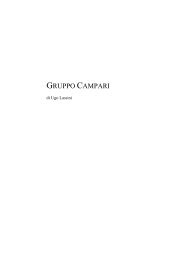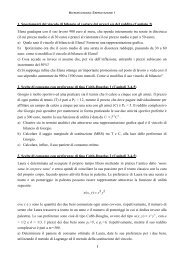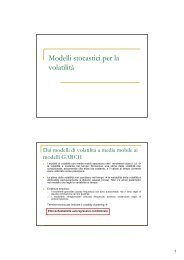Modelli per il Calcolo del Value at Risk
Modelli per il Calcolo del Value at Risk
Modelli per il Calcolo del Value at Risk
Create successful ePaper yourself
Turn your PDF publications into a flip-book with our unique Google optimized e-Paper software.
Esempio di calcolo <strong>del</strong> test di Kupiec<br />
Si consideri <strong>il</strong> back-testing di un VaR(1;99%),<br />
quindi α = 1%, che nel corso dei 250 giorni osserv<strong>at</strong>i<br />
ha prodotto 4 eccezioni (π = 4/250 = 1,6%). Si ha:<br />
LR(<br />
1%)<br />
=<br />
−2⋅<br />
ln<br />
⎛ L(<br />
4 | 1,<br />
6%<br />
= 1%)<br />
⎜<br />
⎝ L(<br />
4 | 1,<br />
6%)<br />
4 250−4<br />
⎛ 0,<br />
01 ⋅0,<br />
99 ⎞<br />
= −2⋅<br />
ln ⎜<br />
= 0,<br />
77<br />
4 250 4<br />
0,<br />
016 0,<br />
984 ⎟ −<br />
⎝ ⋅ ⎠<br />
Il p-value corrispondente a 0,77 <strong>per</strong> una χ2 con 1<br />
grado di libertà è pari al 38%: la scelta di<br />
considerare inadegu<strong>at</strong>o <strong>il</strong> mo<strong>del</strong>lo rifiutando<br />
l’ipotesi nulla ha quindi una probab<strong>il</strong>ità <strong>del</strong> 38%<br />
Slides AB <strong>Mo<strong>del</strong>li</strong> <strong>per</strong> <strong>il</strong> calcolo <strong>del</strong> <strong>Value</strong> <strong>at</strong> <strong>Risk</strong><br />
⎞<br />
⎟<br />
⎠<br />
78
















